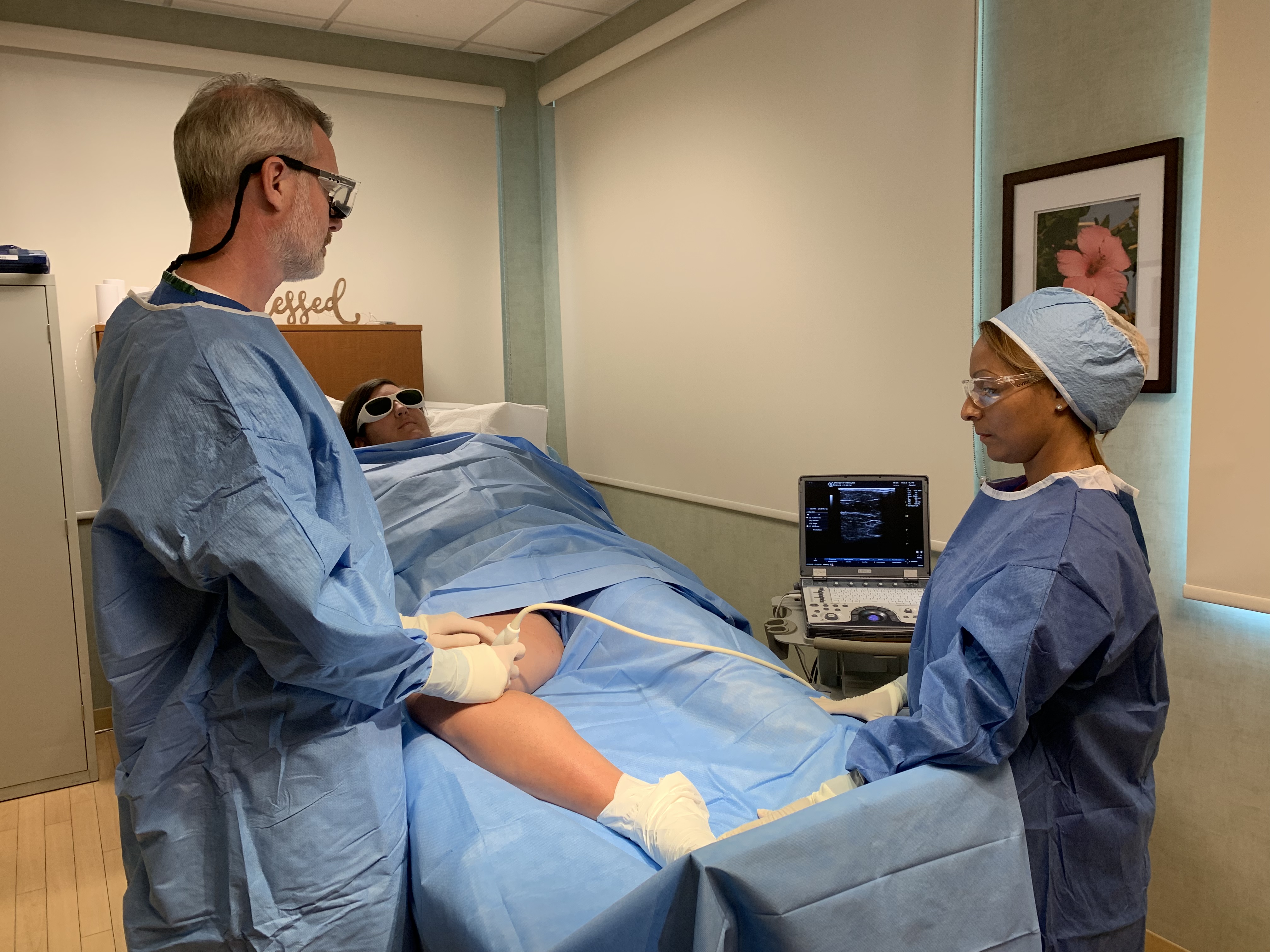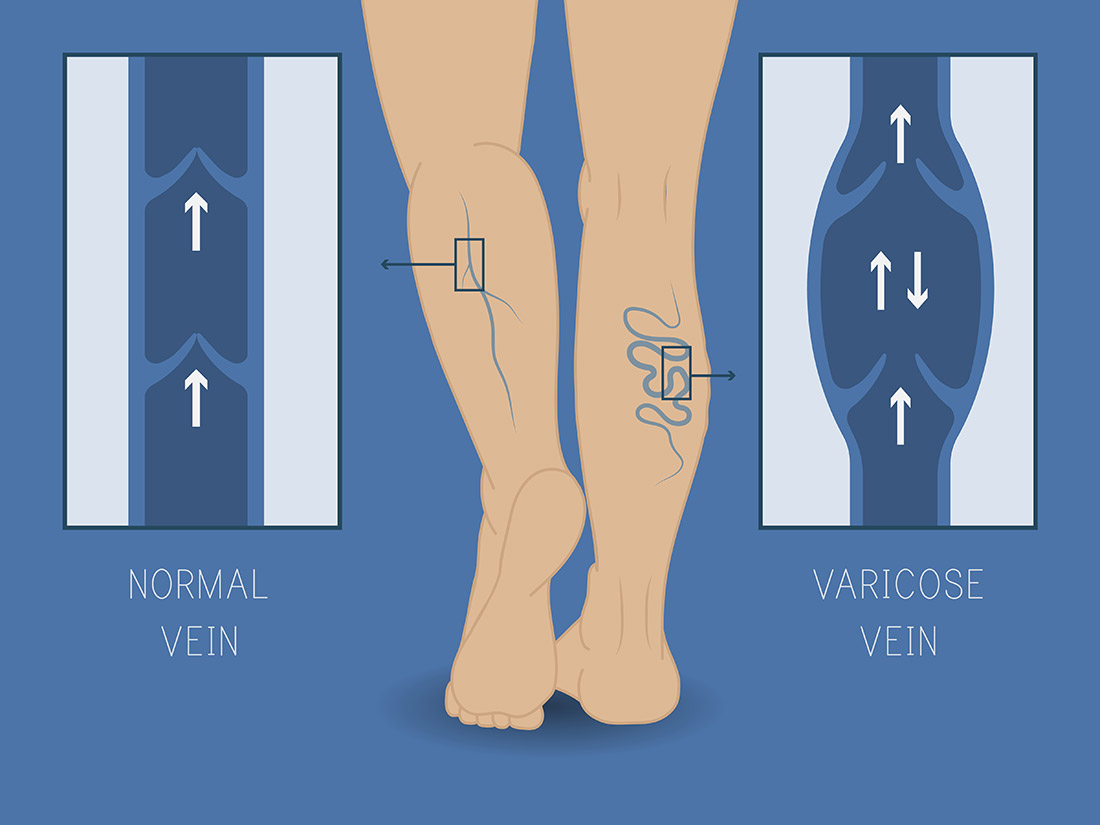Venous Ablation
We have three options to treat reflux in the greater and small saphenous vein. VenaCure ™ and Venefit ™ rely on using heat to close the vein down, while VenaSeal ™ uses a glue to close the vein. All three procedures are similar in that they can be performed in our office using local anesthesia. Patients can drive themselves home after the procedure. They do have to wear a surgical stocking for a week and there may be some bruising but discomfort is minimal and responds to anti-inflammatory medicines such as Celebrex® which is routinely used for one week after the procedure. Most patients return to work the next day. Most insurance carriers will pay for this procedure if it is medically necessary. Complications of blood clots or numbness on the inside of the leg are very rare.
VenaCure ™ relies on heat from a laser fiber to close the saphenous vein. The laser fiber is inserted using a simple injection technique often without any incisions. Under ultrasound guidance it is pulled back out of the vein with the tip of the laser fiber heating the blood. The heated blood causes the vein to scar down and ultimately disappear.
To learn more about VenaCure EVLT, click here (https://venacure-evlt.com)
Venefit ™ also relies on heat created from radiofrequency energy to close the saphenous vein. The Venefit ™ catheter is placed in the saphenous vein under ultrasound. The catheter tip heats the blood and vein wall, causing the vein to scar down and ultimately disappear
VenaSeal ™ is the newest technique to close the saphenous vein. Instead of using heat, the VenaSeal ™ catheter delievers a small amount of medical adhesive throughout the vein. The procedure was developed in the hopes of minimizing discomfort and bruising following closure of the saphenous vein. As VenaSeal ™ is a newer device, not all incurance companies cover the cost of the procedure.
To learn more about VenaSeal ™, click here http://medtronicendovenous.com/patients/7-2-venaseal-closure-procedure/

Injection Sclerotherapy
Injection sclerotherapy involves the injection of an irritant solution into the varicose vein. The solution causes the vein walls to “stick together”. Blood flow is routed to other veins, and the body absorbs the varicose vein. Stockings are worn, for two days after spider vein injection and three weeks after varicose vein treatment, to compress the vein walls together during the healing phase.
Cutera xeo®
The Cutera system is a new treatment involving light to obliterate the veins. It is also useful in removing age spots, tattoos, and unwanted hair. A special machine uses brief bursts of intense light to destroy the vein wall. Although advertised by many as painless most patients state that it feels like they are being hit by a rubber band. It is best used to treat very small veins or those that are left over after injection therapy. We use the Cutera system for treatment of spider veins, a company that has twenty years of experience in the medial aesthetic field.

Microphlebectomy
This procedure also known as Ambulatory Stab Avulsion Phlebectomy (ASAP) effectively removes larger, unsightly or painful varicose veins. A compression stocking will need to be worn for several days following the procedure. In this simple procedure varicose veins are removed through 1/8″ incisions. No stitches are necessary. Surgery is performed on an outpatient basis under local anesthesia and scarring is minimal or non-existent. Results are immediate and normal activity can be resumed promptly. Procedures take from 15 minutes to 2 hours.
Saphenous Vein Ligation
Sometimes the main superficial vein, the saphenous vein, has a leaking valve. In order to get maximum benefit of other vein treatments this vein must be tied. This procedure is performed in an outpatient surgery center under local anesthesia with or without mild sedation. The incision is only about an inch long and is placed just above the groin crease so that it cannot be seen. Plastic surgery techniques with absorbable stitches are used to close the incision. It takes 20 minutes and patients can return to normal activity immediately. It does not result in any pain and the stitches are absorbable.
Stripping
This operation used to be the standard method of treatment for varicose veins. These days it is very rarely required. In this procedure the entire saphenous vein is removed. The procedure requires general anesthetic and some days’ recuperation. It is generally reserved for patients who have such severe varicose veins that they develop discoloration or ulceration of the skin at the ankle or if the visible varicose veins are the saphenous itself. All of these circumstances are unusual. Some surgeons will always remove this vein as part of vein treatment whereas others will try to spare it so that it can possibly be used by heart or vascular surgeons in the future as an arterial substitute.



 Facebook
Facebook
 941-371-6565
941-371-6565  info@veinsandarteries.com
info@veinsandarteries.com